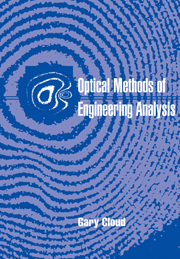Book contents
- Frontmatter
- Contents
- Acknowledgments
- 1 Introduction and orientation
- Part I Optics and interferometry
- Part II Photoelasticity
- Part III Geometrical moire
- 7 Geometrical moire theory
- 8 In-plane motion and strain measurement
- 9 Moire mapping of slope, contour, and displacement
- Part IV Diffraction theory, optical processing, and moire
- Part V Moire interferometry
- Part VI Holographic interferometry
- Part VII Speckle methods
- Author index
- Subject index
9 - Moire mapping of slope, contour, and displacement
Published online by Cambridge University Press: 12 January 2010
- Frontmatter
- Contents
- Acknowledgments
- 1 Introduction and orientation
- Part I Optics and interferometry
- Part II Photoelasticity
- Part III Geometrical moire
- 7 Geometrical moire theory
- 8 In-plane motion and strain measurement
- 9 Moire mapping of slope, contour, and displacement
- Part IV Diffraction theory, optical processing, and moire
- Part V Moire interferometry
- Part VI Holographic interferometry
- Part VII Speckle methods
- Author index
- Subject index
Summary
This chapter describes techniques for using geometric moire to measure out-of-plane displacement and slope, and also for mapping the contours of three-dimensional objects (Chiang 1989; Parks 1987; Theocaris 1964). The ideas are illustrated by an example from biomechanics, which has been a major area of application.
Shadow moire
The shadow method of geometric moire utilizes the superimposition of a master grating and its own shadow (Takasaki 1970; Takasaki 1973). The fringes are loci of points of constant out-of-plane elevation, so they are essentially a contour map of the object being studied. In studies of deformable bodies, the method can be used to measure out-of-plane displacements or changes in displacement. To understand the creation of fringes and to be able to interpret them, consider the optical system shown in the conceptual sketch of Figure 9.1.
A master grating of pitch p is placed in front of an object that has a light-colored nonreflective surface. The combination is illuminated with a collimated beam at incidence angle α. Observation is at normal incidence by means of a field lens that serves to focus the light to a point, where a camera or an eye that is focused on the object is located.
The incident illumination creates a shadow of the grating on the surface of the specimen. The grating shadows are elongated on the specimen by a factor that depends on the inclination of the surface, and they are shifted laterally by an amount that depends on the incidence angle and the distance w from the master grating to the specimen.
- Type
- Chapter
- Information
- Optical Methods of Engineering Analysis , pp. 179 - 192Publisher: Cambridge University PressPrint publication year: 1995

